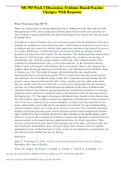Other
NR 393 Week 5 Discussion: Evidence-Based Practice Changes: With Response | GRADED A+
- Course
- Institution
There was much progress in nursing evidence during the 20th century. Choose one area that interests you where the evidence guiding nursing practice changed during the 20th century and tell us about this change. I look forward to reading your ideas!
[Show more]



